First Look: 2018 Honda Gold Wing and Gold Wing Tour

Not many manufacturers can say they’ve had a model in continuous production for 43 years, but Honda can make that claim with their legendary Gold Wing. Over those model years, Honda has set aside just six versions representing what it calls milestone models – the last of which was produced way back in 2001 with the introduction of the GL1800 Gold Wing. The Wing has been well overdue for an upgrade, and the rumor mill was in full-on salivation mode about the prospects of a ground-up remake for 2018.
One might imagine how excited we MOrons were at the opportunity to see the new 2018 Gold Wing in the flesh a full day before it would be unveiled to the rest of the world. With that modest head start, we could have a story – and video – ready in time to showcase the new model and its changes the moment our NDA with Honda expired.
2013 Honda Gold Wing F6B Review
2012 Honda Gold Wing Review – First Ride
Church Of MO: 2006 Honda Goldwing
Yesterday, we jumped on a 2017 Gold Wing at Honda’s Torrance headquarters and took an afternoon blast up to Santa Barbara for a special meeting with Honda’s development team. To say we were impressed at the first glance of the new bike would be an understatement. The difference in size between the new and old Wings was astonishing. The team at Honda, while maintaining the Gold Wing’s touring roots, clearly has put higher performance front-and-center during the development process. Honda says part of the reason for this is that they want to attract more than just the typical older touring rider. They think the new Wing has the performance chops to entice younger enthusiasts, also. To cement that idea, two variants came out from under their covers at the early unveiling. The standard Gold Wing comes without a trunk, offering more streamlined “bagger” styling. The Gold Wing Tour comes with the more touring-oriented and passenger friendly trunk, it also received some model-specific extras. However, both bikes are based on the exact same platform.
The changes made to the new Gold Wing focused on three primary areas: Power delivery and efficiency, handling and weight reduction, and technology. Want a hint about how successful the changes were? The 2018 Honda Gold Wing Tour is 90 pounds lighter than the 2017 model.
New Engine
The 1,833cc SOHC flat-six received a complete makeover for 2018, and when the dust settled, the result was a more powerful engine that is 29mm shorter front-to-back and 13.7 pounds lighter than before (in 6-speed manual configuration). To achieve this shortness, the cylinder bore was dropped 1mm to 73mm (for a perfectly square bore and stroke of 73mm x 73mm), and the distance between bore-centers was shrunk by 9mm to 81mm. Additionally, the cylinder offset from the left and right cylinder banks was reduced by 4mm. Finally, the crankshaft pulser, which is responsible for sensing piston location for the EFI and ignition, was relocated to the rear allowing the engine’s front cover to move 7mm closer to the end of the crank.
The air/fuel mixture is sucked into the newly aluminum-sleeved, pent-roof-type combustion chambers via new four-valve heads. The old engine only had two valves per cylinder. Controlling the tappets is a Unicam valve train that readers may remember from the CRF450R. By allowing the removal of the valve-lifter-support structure from the previous generation, the finger-follower rocker-arm system on the intake side and roller rocker-arm system on the exhaust side deliver both weight savings and add to the engine’s compactness.
The intake is lighter and designed swirl the incoming air to assist in better use of the air filter’s entire surface area, while the ducting shape and size have been tuned for improved throttle response and torque delivery at initial throttle openings. Additionally, only one 50mm throttle body is used now, instead of the previous two.
On the bottom side of the cylinder heads, the exhaust underwent major changes. While previous Wings had a distinctive style, the 2018 model is a different animal. When the Honda representatives started the engine in the display area, I was surprised by how deep and throaty the exhaust note was. There were still hints of the old sound, but the overall effect of the sound was that of muscularity and bit less of a six-cylinder growl.
The resulting engine not only sounds different, but Honda claims it puts out “about 5 more horsepower” than the old Wing. Since Honda doesn’t release horsepower figures, we’ll just have to take their word (and a gander at the graph provided in their press kit). However, that performance increase did not come at the cost of fuel economy. Honda says that the mileage was so improved that, when combined with the Wing’s lessened weight and better aerodynamics, it enabled a 1.1 gallon reduction in fuel capacity (to 5.5 gallons) while maintaining the same touring range of the previous generation. [If you ask MO, we’ll tell you that we’d have been more pleased by an 83 Lb. weight reduction and using that last 7 Lbs to retain that extra gallon of gas…. on a touring bike. -Ed.]
Transmission Options
Readers should not be surprised to learn that the 2018 Gold Wing is available with a 7-speed Dual Clutch Transmission (DCT), particularly since the outgoing model was a manual 5-speed. Honda remains firmly committed to dual-clutch technology and claims the implementation in the Wing is their best iteration, yet. In fact, one Honda rep, who is an avid road racer, said that he wouldn’t consider owning the Wing without the DCT – from a performance perspective. However, Honda realizes that not every rider is interested in this technology, so both 2018 Gold Wing models will also be available with a traditional 6-speed manual transmission + reverse mechanism.
While both the manual transmission and the DCT version have the same final-drive ratio in top gear, the additional cog in the DCT allows the lower gears to be more tightly-spaced, resulting in less engine-speed drop when changing gears. So, the DCT should actually outperform the standard transmission when running up through the gears – which explains why a road racing test rider could say that he prefers the DCT over the standard transmission on the Wing – not to mention the zero lag time between shifts.
One feature of DCT that Gold Wing riders (particularly those with shorter inseams) will probably be most excited about is the new Walking Mode. Available in both forward and reverse, the Walking Mode utilizes one clutch for forward motion and the other for reverse. On DCT equipped Gold Wings, reverse is now provided by the engine and transmission and not by the starter motor as with the previous model. Walking Mode automatically raises the idle speed slightly and then takes care of the tricky modulation of the clutch engagement. Through the use of the + and – buttons on the left handlebar, Walking Mode delivers a top forward speed of 1.1 mph and 0.75 mph in reverse.
Aside from the functional differences between the DCT and the manual transmission, the third generation of Honda’s DCT gained three new rubber dampers to smooth the transmission of power between gears and make shifts even quieter.
The 6-speed manual transmission is exactly what one would expect. However, there are two different variations. The base model Gold Wing does not receive a reverse function, and owners will need to back out of parking spaces the old-fashioned way – with their feet. The Gold Wing Tour with the manual transmission has the same electric reverse implementation as used on the previous generation.
Ride Modes
Since the new engine is controlled by ride-by-wire (RbW), four different ride modes are now available: Tour Mode, Sport Mode, Econ Mode, and Rain Mode. The default Tour Mode provides engine response appropriate for the widest range of riding conditions, balancing power and comfort needs. Sport Mode features more powerful acceleration and snappier throttle response, while on DCT models the rpm are allowed to climb higher. Econ Mode delivers milder acceleration for more relaxed riding in urban/suburban settings with DCT shifting occurring at lower rpm for fuel economy. Rain Mode, not surprisingly, attenuates power in slippery conditions.
Ride by wire also enables other technologies for rider comfort and safety. Traction control in the form of Honda Selectable Torque Control mitigates wheel-spin by adjusting the throttle and fuel injection simultaneously. Another boon to riders is the newly implemented Hill Start Assist, which applies rear brake pressure to prevent the bike from rolling backwards after the rider releases the brakes. Although previously available, the Gold Wing’s cruise control has been updated and had some components eliminated that are now better served by the RbW system.
New Suspenders!
The big news on the Gold Wing’s suspension is the addition of a double-wishbone front end. The shift away from a traditional telescopic fork delivers several advantages. As with all non-telescopic front suspensions, front-end dive is greatly reduced while braking. The second big advantage of those new double-wishbones is better absorption of bumps, thanks to the elimination of the stiction associated with traditional forks. According to Honda, impact shocks delivered from the road to the grips are reduced by 30%. Additionally, Honda claims a 40% reduction in inertial mass in the front end components, which translates into lessened effort for steering inputs. Just sitting on the display bike gives the impression of having the leverage of a much wider handlebar when turning it from lock-to-lock. Unfortunately, we’ll have to wait to see how this feels out on the road, but Honda says the first press rides probably won’t happen until early in 2018.
One unexpected area where the double-wishbone suspension benefits the Gold Wing is in helping to improve the tightness of the vehicle package. With a traditional fork, the wheelbase actually shortens as the sliders compress, requiring extra space be left between the engine and the front tire. With the new double-wishbone suspension, the wheel tracks straight up and down, meaning the engine can be moved closer to the back of the front tire. On the 2018 Wing, the engine’s new location also allows for the rider to be moved 36mm forward on the chassis. This re-positioning of engine and rider weights pays benefits by increasing forward weight bias for more responsive handling.
Out back, a Honda Pro-Link system combines with a Showa shock to control chassis movement. Honda claims that spherical joints at the top and bottom of the shock mitigate the torsion of the Pro-Arm for an improved ride.
But wait, there’s more! For 2018, the Gold Wing Tour model gains electrically adjustable preload with four settings: Rider, Rider + Luggage, Rider + Passenger, and Rider + Passenger + Luggage. (Owners of the standard Gold Wing will still have to remove a side panel and twist a remote hydraulic rear preload adjuster.) Additionally on the Tour models, the front and rear damping settings are linked to the ride modes and adjusted automatically to suit. As the ride modes are selected, stepper motors adjust the needles that control oil flow in the front and rear shock valves, allowing for a firmer or a more plush ride.
Beefier Brakes
When it comes time to slow the beast, riders will have a pair of six-piston radially-mounted calipers squeezing 320mm front rotors at their disposal. How big is the change from last year? Three pistons in conventionally-mounted calipers had only 296mm discs to embrace. The combined (linked) ABS system has been updated to better balance the braking forces applied to the front and rear wheels. In the process, the two-motor system was converted to just a single, smaller, lighter ABS modulator integrated with the brake system’s ECU. Additionally, the ABS settings are linked with the ride modes to have the brake system’s characteristics in line with those of the engine and suspension settings.
Chassis Changes – An All New Frame
Don’t be fooled by the similar look of the the 2018 Gold Wing’s new twin-spar frame. Changing the front suspension and moving the engine forward required a complete redesign. Through the use of different plate thicknesses in various areas of the frame, Honda’s engineers were able to tune different sections of the chassis for specific stiffness and flex characteristics to best suit the rest of the new hardware. All of this was in an effort to achieve a balance of stability and maneuverability. The end result is a more mass-centralized frame that weighs-in 4.4 pounds lighter than its predecessor.
The Gold Wing’s swingarm also received updates. The single-sided unit with internal shaft drive plays a significant role in the chassis’ overall rigidity balance and contributes to the Wing’s improved ride.
Wrapped in a Stunning Package
Up until now, we’ve only been considering the technology and function of the 2018 Gold Wing. The new design also plays an important role in the overall character of the motorcycle. In the case of the new Gold Wing, that personality is a little surprising for a 43 year old touring motorcycle.
The Gold Wing’s visage is narrower and more muscular than the previous generation’s. While keeping the same side-mount radiator system, the engineers were able to narrow the front fairing by about 7.9 inches! In the process, the 2018’s aerodynamic drag has dropped by an impressive 11.8%.
Honda’s reps stressed that, thanks to improved airflow management, the rider and passenger enjoy a completely new riding experience on the 2018 Gold Wing. Rather than trying to place the occupants inside a completely windless bubble, the designers worked to have the wind flow smoothly over them. Consequently, new air ducts flow more air into the cockpit.
A new, electrically-controlled windshield allows the rider to better control the airflow. Previously, the rider had to stop and manually lift/lower the windscreen to account for changing weather conditions. Now, the height can be adjusted on-the-fly as the rider moves from suburban streets to open highways. A cool feature of the windshield is that when the bike is powered off, the screen moves to its lowest position to facilitate easier mounting of a bike cover. As soon as the Wing is powered on, the windshield returns to its previous location.
Earlier we noted that the more forward riding position helped with the bike’s weight bias. Well, the closer rider location means that the windshield can be smaller than last year’s while still providing better protection. Finally, one difference between the two Gold Wing models is that standard versions receive a shorter, but still adjustable, windscreen.
While there is no argument that the Gold Wing’s frontal area was reduced, it’s easy to see in the side-by-side photo above. What is less obvious is that the luggage capacity was also reduced. The 2017 Wing was capable of carrying a total of 150 liters of cargo in its saddlebags and trunk. The 2018 Gold Wing Tour can only carry 73% as much stuff, 110 liters in total – 30 liters in each saddlebag and 50 liters in the trunk. When discussing this change with a Honda rep, we were told that the reason behind this choice was that larger bags looked out of proportion with the front of the bike. The rep acknowledged that, while Honda was sure to face some resistance to the smaller capacity, market research had shown that the average trip these riders took was just three days long, and the cargo for rides of this length should be able to fit in the allotted space. Although we’re not completely sold on the idea of smaller luggage capacity, we will note that the BMW K1600GTL only has 115 liters of storage, meaning the 2018 Gold Wing Tour only falls a little less than 5% behind its closest rival.
Convenience Technology
Touring bikes are created for gobbling up massive amounts of asphalt while keeping the rider and passenger comfortable and entertained. Also, with the Gold Wing being Honda’s flagship motorcycle, it has always been given the privilege of showcasing the best that the company has to offer. So, MO had high hopes as to what was in store for the next Wing. We’ve already covered niceties like the electronically adjustable windscreen and suspension plus the Hill Start Assist. But those are features that have been around on other brand’s bikes for a long time, thankfully there’s more.
The instrument cluster has grown to be even more of a “dash” that it was before. Front-and-center is the exceptional 7-inch TFT display screen which houses the menus for the rider aids and audio system. Most importantly, the TFT is home base for the navigation system – which is important for far-flung journeys. The Gold Wing’s GPS is standard equipment for all versions. The big surprise about the GPS is that it comes with 10 years of free updates from Honda, and that’s bound to make long-term owners happy!
Another key feature to the new TFT is Apple CarPlay integration which will give riders access to their favorite entertainment and navigation apps. Users with Bluetooth headsets will also have Siri integration and the ability to play audio directly through their helmet speakers instead of always through the Wing’s onboard speakers. Android users shouldn’t worry, though. Honda is working to integrate Android Auto into a future firmware upgrade.
As is becoming more common in luxury model motorcycles, the Gold Wing features a keyless ignition. In fact, there is no slot for an ignition key on the bike – just a knob atop the center console. The saddlebags and trunk locks are also controlled by the key fob, and they open electronically with the push of a soft-touch button. If you don’t have your fob with you, the bags will not let you close them. They’ll just pop back open. Similarly, you can’t lock the fob inside one of the bags.
One cool feature of the key fob is its on/off switch which disables the wireless function. This nice touch will keep strangers from being able to open your bags or start the engine if your fob is in range. While this is an esoteric touch, it shows the level of thought that Honda has put into the Gold Wing’s makeover.
It’s All Over but the Waiting
In this sneak peak that Honda gave MO on the Monday before the 2018 Gold Wing’s unveiling to the public, we’ve been impressed with just how much has changed on this storied motorcycle. These changes add up to a more powerful machine that is 90 pounds lighter than its predecessor. It also gets better fuel economy – to the tune of Honda claiming it’s able to travel the same distance on a tank that is now one gallon smaller. Riders get the choice of a traditional manual 6-speed or a 7-speed DCT. The addition of Ride by wire brings with it a number of nice changes from ride modes to electronically adjustable suspension settings that are linked to those mode. Honda says the new double-wishbone front suspension represents a huge change in both ride comfort and performance. Finally, the rider and passenger accommodations promise better airflow management in addition to new entertainment and communication options.
Then there’s the fact that Honda has built two Gold Wing models, one with a trunk and one without. For base Gold Wing buyers who decide later that they want the trunk, accessory add/remove trunk kits will be available from Honda. That way, riders who want the more advanced suspension of the Gold Wing Tour can have the trunkless “bagger” style back end of the base model, if they like. The standard Gold Wing’s MSRP begins at $23,500, and the Gold Wing Tour ranges from $26,700 to $31,500.
Now comes the bad news for riders who are as excited to throw a leg over the 2018 Honda Gold Wing as we are. The bikes won’t be in dealerships until February of 2018. While that’s not a terribly long time to wait, you won’t get to hear the beefy exhaust note from its shapely mufflers. The sound of the flat-six is, as it has always been, intoxicating.
2018 Honda Gold Wing Specifications | ||
|---|---|---|
Honda Gold Wing | Honda Gold Wing Tour | |
| MSRP | $23,500 – $23,800 (6-speed) $24,700 – $25,000 (DCT) | $26,700 – $27,200 (6-speed) $27,700 – $28,200 (DCT) $31,500 (DCT & Airbag) |
| Engine Type | 1,833cc horizontally opposed six-cylinder | |
| Bore and Stroke | 73mm x 73mm | |
| Fuel System | EFI, 50mm throttle body | |
| Compression Ratio | 10.5:1 | |
| Valve Train | Single overhead Unicam® w/ 4 valves per cylinder, finger-follower rocker arm on intake, roller-rocker arm on exhaust | |
| Transmission | 6-speed manual or 7-speed automatic DCT w/ Walking Mode F/R | 6-speed manual w/ Reverse or 7-speed automatic DCT w/ Walking Mode F/R |
| Final Drive | Shaft | |
| Front Suspension | Double-wishbone front-suspension system w/ Showa shock absorber, 4.3 in. travel | |
| Rear Suspension | Pro-Link® system w/ Showa shock absorber, 4.1 in. travel | |
| Front Brake | Two radially mounted 6-piston Nissin calipers w/ 320mm rotors, electronically controlled combined ABS | |
| Rear Brake | 3-piston Nissin caliper w/ 316mm rotor, electronically controlled combined ABS | |
| Front Tire | 130/70-18 | |
| Rear Tire | 200/55-R16 | |
| Rake/Trail | 30.5° / 4.3 in. | |
| Wheelbase | 66.7 in | |
| Seat Height | 29.3 in. | |
| Curb Weight | 787 lbs. 800 lbs. (DCT) | 833 lbs. (6-speed & DCT) 842 lbs. (Air Bag DCT) |
| Fuel Capacity | 5.5 gal. | |
| Available Colors | Candy Ardent Red, Matte Majestic Silver, Pearl Stallion Brown | Candy Ardent Red, Pearl White, Pearl Hawkseye Blue |

Like most of the best happenings in his life, Evans stumbled into his motojournalism career. While on his way to a planned life in academia, he applied for a job at a motorcycle magazine, thinking he’d get the opportunity to write some freelance articles. Instead, he was offered a full-time job in which he discovered he could actually get paid to ride other people’s motorcycles – and he’s never looked back. Over the 25 years he’s been in the motorcycle industry, Evans has written two books, 101 Sportbike Performance Projects and How to Modify Your Metric Cruiser, and has ridden just about every production motorcycle manufactured. Evans has a deep love of motorcycles and believes they are a force for good in the world.
More by Evans Brasfield



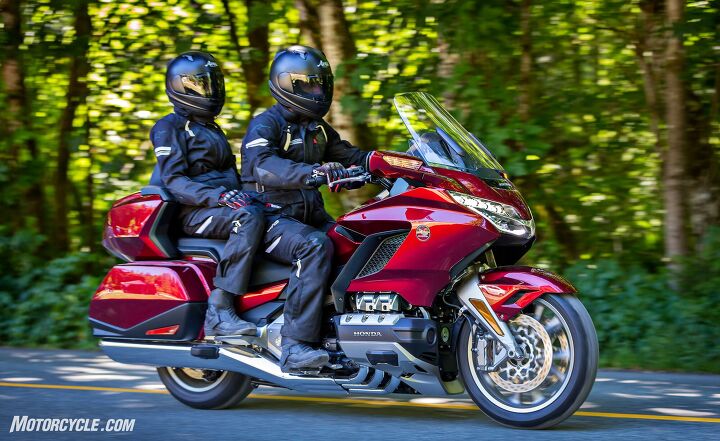
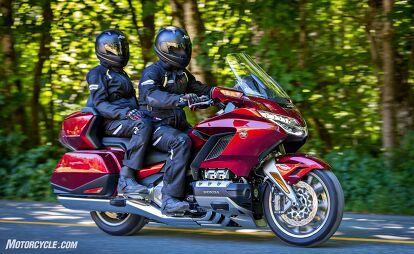
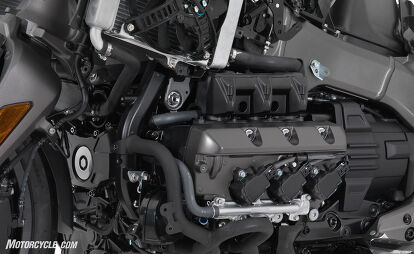


















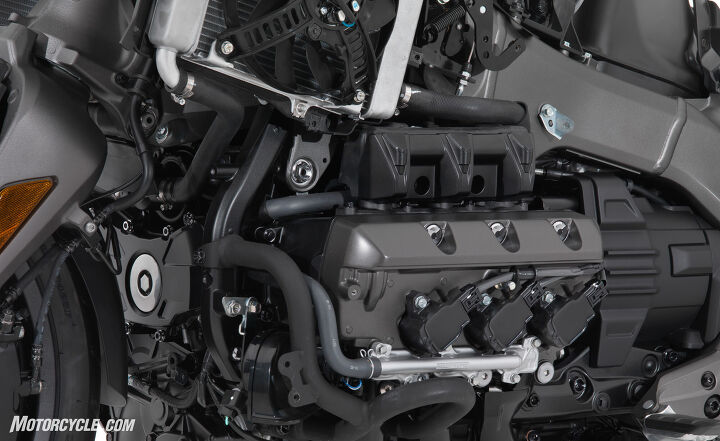








































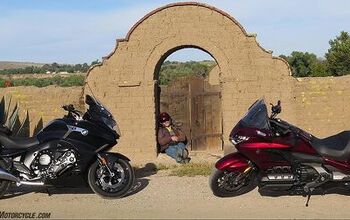
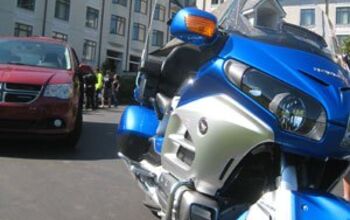
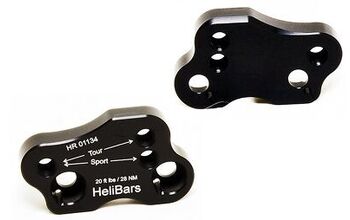
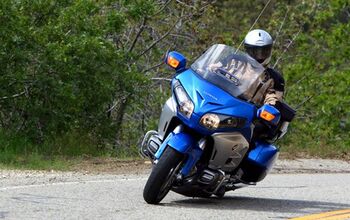












Comments
Join the conversation
I had an opportunity to ride the 2018 GL1800 touring, 6 speed manual today. This is an awesome machine to ride. I will say there's features that the BMW K bike already have, but the Goldwing has the BMW beat in appearance. Gonna get me one asap.
https://uploads.disquscdn.c...
I rented and rode this bike in Middle TN for 246 miles over 24 hour period. I fit in about as many elements of riding as I could have in that amount of time.
1. Nachez Trace
2. Back-roads, both flat and rolling
3. Small towns cities and streets.
4. Large busy city streets.
5. Freeway- I - 840, I-24
6. Recently scrapped (pre-repaving) roads
7. Some dirt over roads due to construction and recent rains.
My experience riding types:
2006 Yamaha TTR 250
Yamaha TTR 200
HD Sportster 1200
Kawasaki Ninja 750 Circa 1992 yes I'm old.
Long endo runs,
Recreational motor cross ( nothing crazy.. I'm old),
ATV parks and trails.
I was always very interested in a touring bike concept, riding in groups and for long distances. I checked into several clubs in my area, and also researched the different bike types on line to see what may fit the bill, if I ever choose to purchase a bike.
I wanted something VERY affordable, and that if I took good care of.. I could sell it for at or maybe even more than I paid for it!! ( make your money when you buy it!)
I am NOT . .I repeat NOT mechanically inclined. I know how to put gas in, read an odometer and know when it says check engine...it's not good.. have someone check the engine, like yesterday.
Being short, stocky and not in very great shape, the idea of a huge monster I see on the road quickly ended. I mean don't get me wrong I love those bikes, and the are works of art, but the thought of dropping on of those huge chrome sculptures over on it's side in front of a huge group of experienced bikers was intimidating. What I did not want was a bike so heavy it would fall out of my control and into another bike, or rider minding their own business next to me.
I also felt renting a bike or two may make sense. Eagle riders at Sloan's in Murfreesboro TN has a good program to rent. I am not plugging them at all, but it is a good service, that could be a completely different topic to review.
So I was able to rent a 2018 Honda Goldwing for 257.00 for basically 24 hours and up to 250 miles. That included all taxes, and additional insurances, which I opted in for, just in case.
After planning out my ride to get the most of it, here are my thoughts on the bike.
I am in no way a professional rider!! Not claiming to be, at all, this is just my take on the bike as I rode it.
Weather: Perfect 50 - 70 Clear dry sunny day
Road Conditions: Perfect Dry Asphalt and Concrete Some areas were grooved and being resurfaced. Some areas had dry dirt and sand as a result of recent heavy rains.
Extra Stuff: Apple I-phone 6 Plus, Normal riding gear, ( weather proof pants,gloves,boots, full face helmet with mask but mask was up, used clear safety glasses for eye protection instead.
Engine Type1,832cc liquid-cooled horizontally opposed six-cylinder four-stroke
Valve TrainSingle overhead Unicam® w/ 4 valves per cylinder, finger-follower rocker arm on intake, roller-rocker arm on exhaust
Bore x Stroke73mm x 73mm
Compression Ratio10.5:1
InductionSingle throttle w/ 50mm bore, Throttle By Wire (TBW)
IgnitionFull transistorized ignition
Transmission6-speed manual w/ Reverse7-speed automatic DCT w/ Walking Mode F/R6-speed manual7-speed automatic DCT w/ Walking Mode F/R
ClutchMulti-plate wet clutch(2) multi-plate wet clutchesMulti-plate wet clutch(2) multi-plate wet clutches
Final DriveShaft
SUSPENSION
FrontDouble-wishbone front-suspension system w/ Showa shock absorber; 4.3 in. travel
RearPro-Link® system w/ Showa shock absorber, 4.1 in. travel
BRAKES
Front(2) radially mounted 6-piston Nissin calipers w/ 320mm rotors, electronically controlled combined ABS
Rear(1) 3-piston Nissin caliper w/ 316mm rotor, electronically controlled combined ABS
TIRES
Front130/70-18
Rear200/55-R16
MEASUREMENTS
Rake (Caster Angle)30.5°
Trail 109mm
Length101.4 in.97.4 in.
Width36.4 in.35.6 in.36.4 in.35.6 in.
Height56.3 in. low windscreen; 61.2 in. high windscreen52.8 in. low windscreen; 56.9 in. high windscreen
Seat Height29.3 in.
Ground Clearance 5.1 in.
Wheelbase66.7 in.
Fuel Capacity5.5 gal.
ColorCandy Ardent Red, Pearl White, Pearl Hawkseye BlueCandy Ardent Red/BlackCandy Ardent Red, Matte Majestic Silver, Pearl Stallion Brown
Curb Weight*833 lbs.842 lbs.787 lbs.800 lbs.
So how did it ride?
Again I am not pro and honestly I was hoping for a much better bike. Over all I'd rate it a 6 out of 10..maybe with more time and further customizations those numbers would improve.. but this is what I give the bike I road.. and here is why.
1. It felt to me to be VERY plastic. What does that mean? Every time I pressed a button or control I thought I wonder how long it would take that to break. Maybe I am just a pessimist? All of the connections are plastic to plastic, as far as I could tell anyway? I understand they reduced the weight of this bike 90 pounds from the last model, and you can tell they asked the design team in meetings.. how can we make it lighter, lighter, and lighter, well that, In my view gives it a feel of being cheap, almost toy like.
2. Power Mode and Selector ( Rain, Touring, Sport, Economy)
These were cool. I could feel a difference between Sport and the others, and Touring added another "GEAR" 6 on top of the normal "5". The power seemed adequate most of the times except on the highway. Please understand, I am NOT an expert biker but I think I do know when I feel like I am getting blown around, winds on the highway, may have been between 10 and 15 knots but not really steady. In any case, it seemed like the bike was moving a lot without my input.. forcing me to keep on it and pay really good attention. I thought Goldwings were famous for being rock steady and holding the road and their lines with little input? Well to me, this bike felt like a dirt bike on the interstate.
3. Balance: This was a very nice feature. The bike was very easy to control and ride with just a leg and weight balance shift, at all speeds. it comes in at 800 pounds, but to me it felt like a dirt bike, I'll be it, at the end of the day , when your tired....My thought is, and I may be way off, it may be the front forks? All I do know is when the winds were calm now and then riding the bike hands off, just to feel it, proved the bike felt like it was on autopilot.
4. Steering: I don't know how other bikes stack up here at all? So I will just comment on my observations. You can't see the front assembly, or tire or fender at all, maybe you never could on these or for that matter other bike? To my knowledge the only feedback you have as to "where" the front tire is are the handle bars and those seem to be very compact. They remind me of a small racing bike.
5. Seat, Grips, Pegs, Shift Levers, Cup holders, USB Ports, Cigarette Charger Socket, Windshield: My entire intention in renting a touring bike was to see if I would like being on a bike for long trips and long amount of time. So my assumption was the "creature comforts" would be important. I am only 5 foot 7 inches tall, and for me, everything, even the ground was well within reach and at a comfortable distance. The bike I rented had an adjustable windshield, and I had it up the entire way, my legs were protected from most of the wind , but I do see the reason for the need of additional screens, more foot pegs, and a back rest. The need for all these extras, on all bikes, makes sense that filling need is an entire industry. As you can imagine with a RENTAL I had a very stock version, that I couldn't alter at all, however there is only 1, I repeat, 1 USB connector in the Phone pocket that is located between the legs. This also interacts with the bike's audio system. The rental staff had it set up for me before I took off, but then later it needed reconfigured. This wasn't easy and I consider myself fairly technical. I am sure that once those conflicts are fixed and resolved between Apple Play, your phone's systems and the standard radio and blue tooth links work? However it has more than a few ways to mess up the connections... ( i know I did!)
Speakers: Not sure if people still use them at all? But if you want to use the stock ones, they suck. The linking up of the Bluetooth was pretty easy, The nice folks at the rental place had me all set up properly, but then something happened during the trip I reset everything and just couldn't get it back properly. It wasn't the bike! However, research Apple Play and the bike because I think they either love each other, hate each other, or cheat on each other..
Engine and shifting:
This seemed nice and powerful, and smooth in most cases, but lacking in others?
The shifting was very smooth, at "above posted" hi way speeds the bike responded very well but you could feel when it was reaching the edge it's power and stability window.
End Game? Would I buy this bike, as is? No.
Why, I think it's under powered, underweight and it just doesn't have that classic Gold wing look.. it looks a lot like every bike out on the road. I realize that companies need to change to their changing markets.. age, income, activity levels.. but on this one, I think they should have went 100 percent the other way!! Right now younger people with money are buying 1960s houses, furniture, cars and trucks, clothing, and once again, making everything old new again...In my humble opinion the changes, not all , but most, make this bike a bit too much like every other bike, not sure anybody who saw it when I stopped the few times I did even know it was a "GoldWing!"